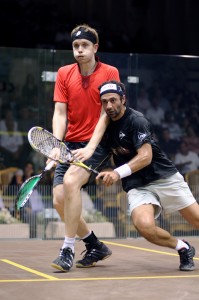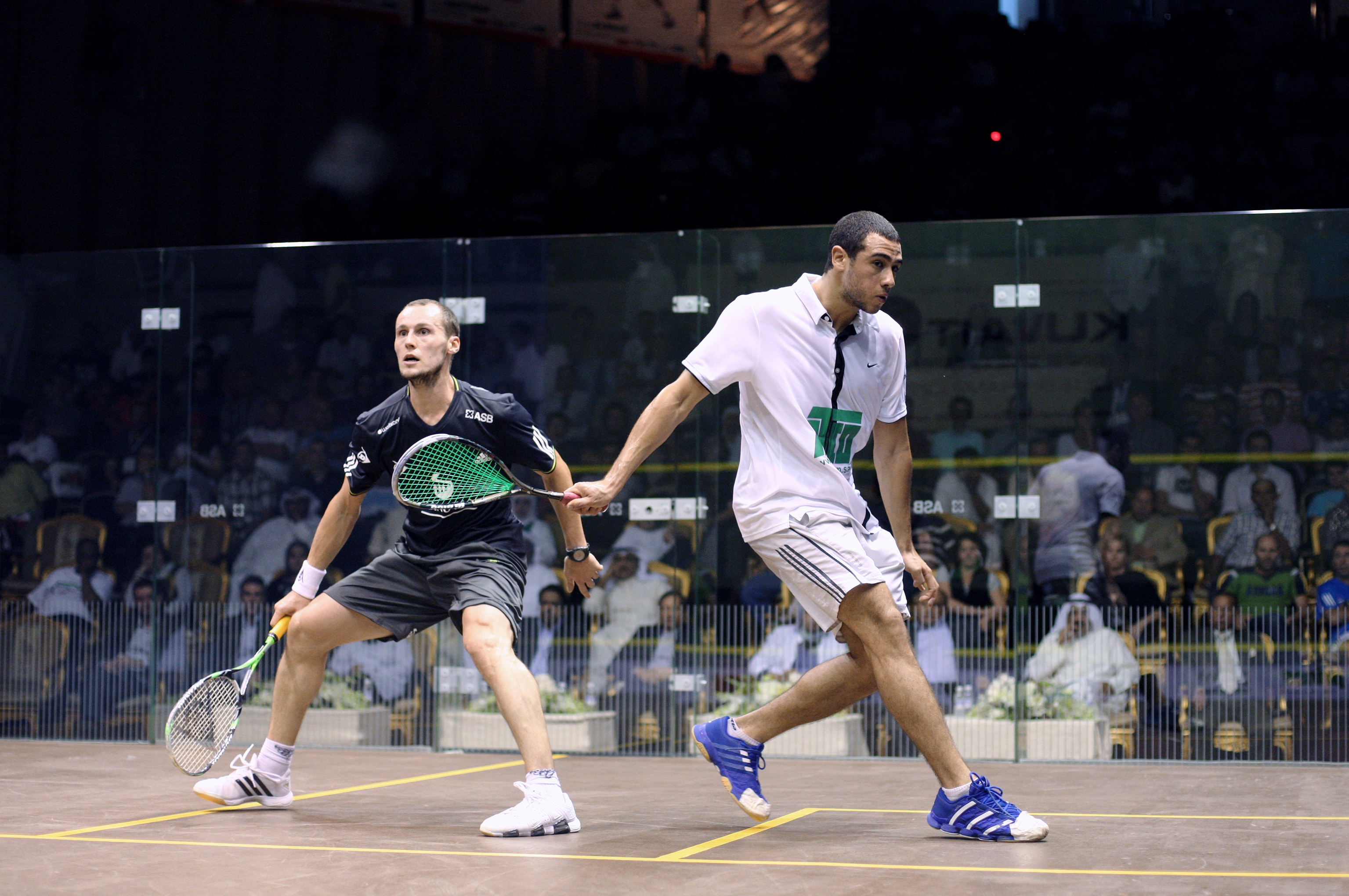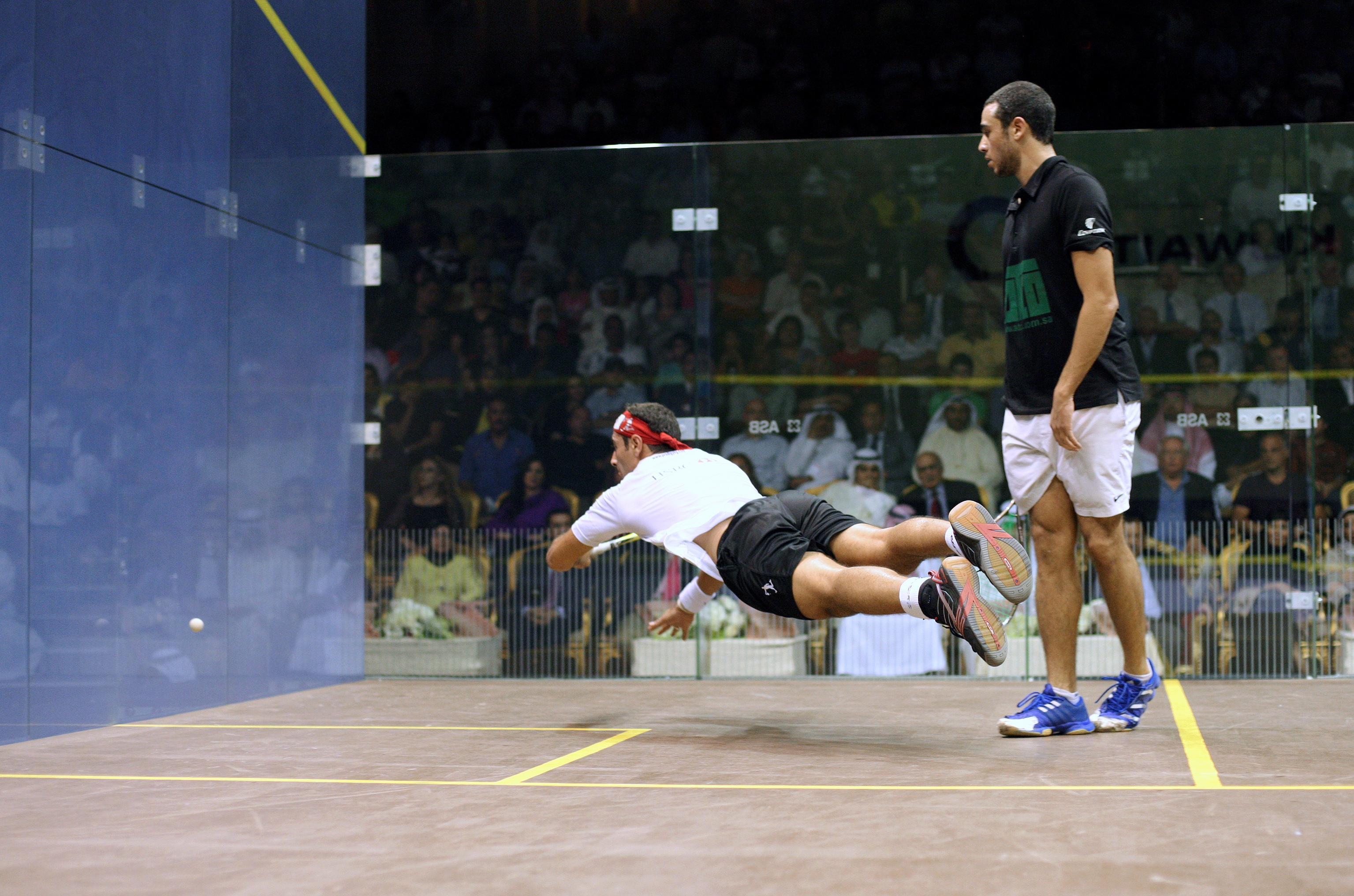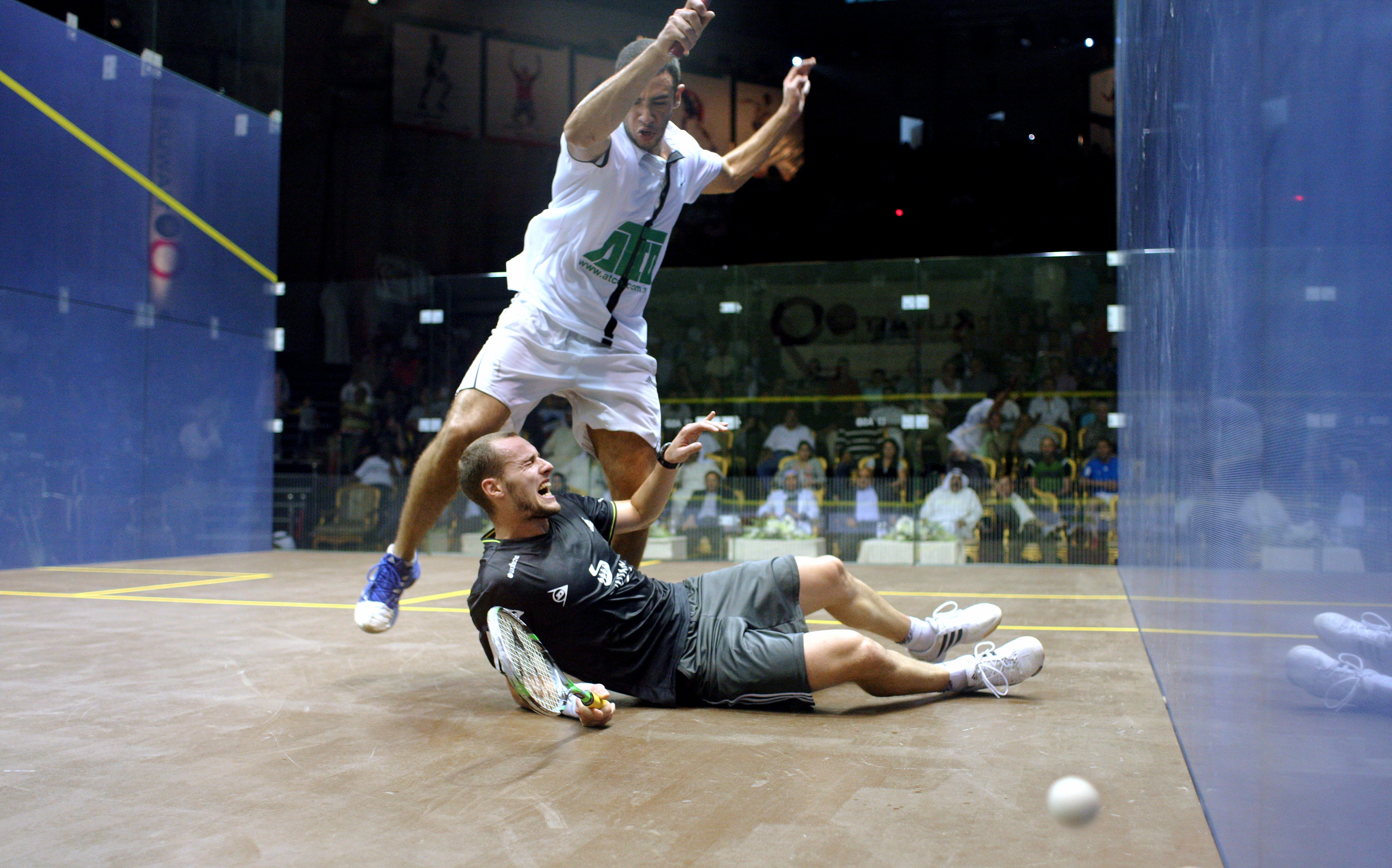
By Richard Eaton
Photos by Steve Line/SquashPics.com
No player in the history of the game can have received as spectacular a response to the capture of a World Open title as Amr Shabana did for his fourth, which surely secured his place in the pantheon of the greats. Despite this, it would be easy to misunderstand the meaning. Soaring across the night sky were huge chrysanthemums, swarms of green bees, darting comets, explosive glitter, strings of pearls, spreading palms, and woven gold clusters, illuminating Kuwait’s giant artificial island, making itself heard well into the hinterland of Iraq, and causing a thousand colors to dance on the surface of the Persian Gulf.
 But although Shabana’s 11-8, 11-5, 11-5, win over his compatriot Ramy Ashour placed him alongside the great Geoff Hunt who also won four World Opens, and behind only the two ultra-legends, Jahangir Khan (six) and Jansher Khan (eight), the explosive 20-minute firework display had not been intended for that.
But although Shabana’s 11-8, 11-5, 11-5, win over his compatriot Ramy Ashour placed him alongside the great Geoff Hunt who also won four World Opens, and behind only the two ultra-legends, Jahangir Khan (six) and Jansher Khan (eight), the explosive 20-minute firework display had not been intended for that.
Squash means more in Kuwait perhaps than any other country, and Shabana had become part of something greater than just a sport, something symbolizing the conquest of a far more frightening opponent—Saddam Hussein.
Through the Liberation Cup, won by Jahangir in 1992, the sport became a vehicle for celebrating the nation’s escape from one of the world’s worst tyrannies; later its open tournament was used to commemorate a prematurely deceased member of the royal family, Sheikha Al Saad.
In this highly-charged context a small fortune had been poured into the pyrotechnics that celebrated the showdown of the richest World Open, a $277,500 event during which Shabana showed he had added tactical and psychological dimensions to his highly expressive game. In the process he became the most successful player of this millennium.
But the final did not live up either to the history or the riches. Ashour was never in serious contention after leading 6-4 in the first game. It did, though, have its own fascination because Shabana won, not with the exciting strokes one often associates with him, but with accuracy and pragmatism. He also won it in the head. “It was a very mental match,” he said.
So effective was the 30-year-old Egyptian’s thoughtful containment, economy of effort, and respect for the orthodoxies, that he gradually made Ashour fret, lose focus, and contribute to his own destruction. At the end Ashour disappeared from the arena, overwhelmed by the need for private tears. His sudden unobserved departure delayed the prize-giving by a quarter of an hour, put a few officials in a flap, and demonstrated how great is the frustration of a talent which many thought would be indisputably the sport’s most successful by now. And raised the question as to whether it ever will.
Shabana was in no doubt about his answer to that. “He’s going to get to quite a few finals before he is done,” he reckoned. “It was my day today, but I am sure he will get plenty more.” But is that really so? There were hints of self-destruction in Ashour which suggested that, even at the age of only 22, the need for greater stability is pressing. This feeling was made more conspicuous by the mature contrast from Shabana—watchful, level-headed, and capable of containing his opponent, either until an opening emerged or until he self-destructed. Increasingly it was the latter.

It was mature too, in that when interviewed in English Shabana still spoke to the crowd in Arabic—which they loved—but minus familiar jokes about being able to call the interviewer all sorts of rude names and still see him smile. Appropriating a Middle Eastern event for its own inter-linked cultures is a serious business. Shabana was aware of the difficulties with which Ashour has been struggling, but loyally did not let on. Partly these have been due to injury but increasingly to psychological factors. That was certainly so in the final, where he worried unnecessarily about refereeing mistakes, and rarely played at his best.
“I have nothing to say,” said Ashour—and then said plenty. “All I can say is that he played very well. He was more consistent than I was. The referees f______ me up.” They were not Ashour’s only wayward moments. He erupted into some racket throwing in a match against Peter Barker, during which he got a code violation warning, and became sucked into a strangely fruitless dialogue with the referee in his semifinal with Gregory Gaultier.
But Shabana was not so sympathetic to this. “It’s a difficult job, and it’s never going to be 100 percent,” he said. “You get calls you don’t like, and you have to live with them.”
Shabana was helped significantly by the introduction of a rest day before the final, for he had had an 80-minute semifinal with James Willstrop before winning 11-5, 11-9, 6-11, 11-9. Indeed this innovation may even have influenced the destination of the title.

“It was good to have that—it’s as it should be,” Shabana said. “Often in the past you don’t get a good final because someone is tired by the time they get there. But I should be rested, and should be fresh for the final.” It was not surprising he felt so, as Willstrop proved to be his toughest opponent, and at 9-8 in the fourth, had looked capable of taking the match to a final game which he might have been favored to win. Earlier the Englishman had accounted for Karim Darwish, the top seed, and Thierry Lincou, the former world number one, and appeared almost back to the form that made him the world’s second ranked player in 2005.
Those who sensed the increase in Shabana’s commitment in the weeks leading up to this World Open might have predicted its outcome; but those who witnessed only the semifinals would definitely not. During these Ashour had played with enough discipline to lure his opponent into contributing to his own downfall instead of himself. Gregory Gaultier’s post-match rant against the refs after his 11-5, 11-9, 12-10, loss to Ramy Ashour, he still has work to do in that area. There were other factors that led to the new world number one’s defeat though, one being the sandy court, a repeated problem throughout the tournament. At 9-8 in the second game Gaultier, lunged towards a clinging drop, and found his front foot sliding away from him, dragging his legs almost into a complete splits. After treatment he lost three points in a row and the crucial second game. From appearing likely to reach one game all, he was two down, a blow from which he never recovered. Many people had thought Gaultier, twice a former finalist, had been ready to go all the way. But it is possible he had been slightly diminished by a hard quarterfinal late the night before with Nick Matthew, the British Open champion.
At 3-1 up in the fourth game and two games to one in the lead, the Englishman looked well capable of beating the Frenchman, and Gaultier only survived in a fortune-swaying contest that lasted 83 minutes. His eventual 8-11, 11-8, 2-11, 11-6, 11-4, win was an impressive effort. Gaultier achieved it partly because he was able to inject extra pace in the second, fourth and fifth games, but also because, having played a poor third game, he found the mental resources to put it behind him

The tournament’s biggest upset? Probably the first round loss by David Palmer, twice a former World Open champion, by 14-12, 12-10, 11-7, to Tarek Momen, one of many ominously improving Egyptians. It was the 33-year-old Australian’s worst result for more than a decade, caused, he claimed, by lack of top match practice since coaching at the University Club in Boston. It triggered speculation that this World Open might be Palmer’s last. Instead, he hopes to make it to the 2010 event in Saudi Arabia before quitting.
Despite the surprises and the drama, one of the most powerful abiding memories remains the venue—the water-bordered Green Island, more than 3,000 meters across, which had been formed by extending the mainland, surrounding it with imported rocks and sand, and linking it to the waterfront by a passageway of 130 meters.
Blessed with a swimming pool which ebbs and flows with the tide, with a 700-capacity amphitheater, and with l50,000 colored shrubs and seedlings, it more than maintained the sport’s reputation for fitting alongside the world’s startling landmarks.
One couldn’t help thinking that squash would have looked great with Sugar Loaf Mountain in the background too. Did the WSF make the point about squash’s ubiquitous nature sufficiently well to the IOC? No sport could have achieved better photos for the 2016 Games.





